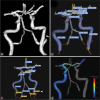Virtual test occlusion for assessing ischemic tolerance using computational fluid dynamics
- PMID: 34513145
- PMCID: PMC8422534
- DOI: 10.25259/SNI_439_2021
Virtual test occlusion for assessing ischemic tolerance using computational fluid dynamics
Abstract
Background: Ischemic tolerance has been evaluated by the balloon test occlusion (BTO) for cerebral aneurysms and tumors that might require parent artery occlusion during surgery. However, because of its invasiveness, a non-invasive evaluation method is needed. In this study, we assessed the possibility of virtual test occlusion using computational fluid dynamics (CFD) as a non-invasive alternative to BTO for evaluating ischemic tolerance.
Methods: Twenty-one patients who underwent BTO were included in the study. Virtual test occlusion was performed using CFD analysis, and the flow rate (FR) and wall shear stress (WSS) of the middle cerebral artery on the occlusion side were calculated. The correlations between these parameters and examination data including the parameters of computed tomography perfusion during BTO were assessed and the cutoff value of CFD parameters for detecting the good collateral group was calculated.
Results: The FR was strongly correlated with mean transit time (MTT) during BTO and moderately correlated with collateral flow grade based on angiographic appearance. The WSS was moderately correlated with collateral flow grade, mean stump pressure (MSP), and MTT. Furthermore, the FR and WSS were strongly correlated with the total FR and the diameters of the inlet vessels. The cutoff value of FR for detecting the good collateral group was 126.2 mL/min, while that of the WSS was 4.54 Pa.
Conclusion: The parameters obtained through CFD analysis were correlated with collateral flow grade and MSP in addition to MTT. CFD analysis may be useful to evaluate ischemic tolerance as a non-invasive alternative to BTO.
Keywords: Balloon test occlusion; Computational fluid dynamics; Computed tomography perfusion; Flow rate; Wall share stress.
Copyright: © 2021 Surgical Neurology International.
Conflict of interest statement
There are no conflicts of interest.
Figures



Similar articles
-
Ischemic Tolerance Evaluated by Computed Tomography Perfusion during Balloon Test Occlusion.J Stroke Cerebrovasc Dis. 2020 Jun;29(6):104807. doi: 10.1016/j.jstrokecerebrovasdis.2020.104807. Epub 2020 Apr 13. J Stroke Cerebrovasc Dis. 2020. PMID: 32295733
-
Balloon Test Occlusion of Internal Carotid Artery in Recurrent Nasopharyngeal Carcinoma Before Endoscopic Nasopharyngectomy: A Single Center Experience.Front Oncol. 2021 Jul 6;11:674889. doi: 10.3389/fonc.2021.674889. eCollection 2021. Front Oncol. 2021. PMID: 34295815 Free PMC article.
-
Rationale for graft selection in patients with complex internal carotid artery aneurysms treated with extracranial to intracranial high-flow bypass and therapeutic internal carotid artery occlusion.J Neurosurg. 2018 Jun;128(6):1753-1761. doi: 10.3171/2016.11.JNS161986. Epub 2017 Jun 2. J Neurosurg. 2018. PMID: 28574313
-
Intracranial endovascular balloon test occlusion: indications, methods, and predictive value.Neuroimaging Clin N Am. 2013 Nov;23(4):695-702. doi: 10.1016/j.nic.2013.03.015. Epub 2013 May 30. Neuroimaging Clin N Am. 2013. PMID: 24156859 Review.
-
Relationship Between Coronary Fractional Flow Reserve and Computational Fluid Dynamics Analysis in Moderate Stenosis of the Coronary Artery.Circ Rep. 2020 Sep 25;2(10):545-551. doi: 10.1253/circrep.CR-20-0078. Circ Rep. 2020. PMID: 33693179 Free PMC article. Review.
Cited by
-
Sub-satisfactory recanalization of severe middle cerebral artery stenoses can significantly improve hemodynamics.Front Cardiovasc Med. 2022 Sep 29;9:922616. doi: 10.3389/fcvm.2022.922616. eCollection 2022. Front Cardiovasc Med. 2022. PMID: 36247480 Free PMC article.
References
-
- Adams GL, Madison M, Remley K, Gapany M. Preoperative permanent balloon occlusion of internal carotid artery in patients with advanced head and neck squamous cell carcinoma. Laryngoscope. 1999;109:460–6. - PubMed
-
- Charbel FT, Zhao M, Amin-Hanjani S, Hoffman W, Du X, Clark ME. A patient-specific computer model to predict outcomes of the balloon occlusion test. J Neurosurg. 2004;101:977–88. - PubMed
LinkOut - more resources
Full Text Sources
Research Materials
Miscellaneous
